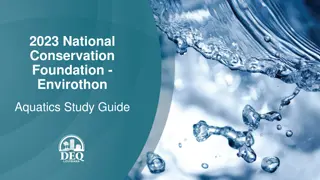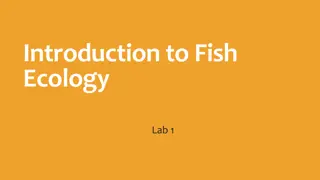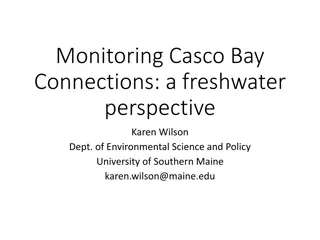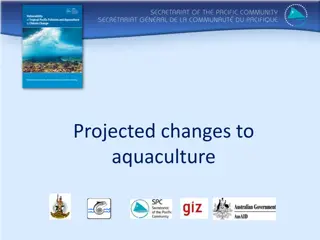Understanding Ecosystems: Types, Components, and Interactions
Different types of ecosystems, their components, and how they interact with each other. Explore natural ecosystems, such as deserts and rainforests, as well as artificial ecosystems. Discover the importance of terrestrial, aquatic, forest, marine, freshwater, tundra, and grassland ecosystems.
4 views • 6 slides
Understanding the Fascinating World of Fishes: A Comprehensive Overview
Fishes, the most numerous vertebrates on Earth, exhibit incredible diversity across various groups such as Agnatha, Chondrichthyes, and Osteichthyes. From jawless Agnatha like lampreys to bony Osteichthyes including lobe-finned and ray-finned species, fishes display unique characteristics and adapta
6 views • 8 slides
Understanding Batrachospermum: A Freshwater Red Alga
Batrachospermum, a red alga commonly found in freshwater habitats like streams, ponds, and lakes, is characterized by its beautiful, gelatinous thallus structure. The plant body grows up to 15-20 cm and exhibits varying colors based on light exposure. Its thallus is differentiated into prostrate and
3 views • 17 slides
Understanding the Positive and Negative Aspects of Fishes
Dr. Mohammad Hamed Bahnasawy, a Professor of fish biology, discusses the positive aspects like diversity and importance of fishes, alongside the negative aspects such as poisonous and venomous fishes, highlighting toxins present in different fish species and risks associated with consumption.
2 views • 28 slides
2023 National Conservation Foundation - Envirothon
Explore the intricate dynamics of aquatic ecosystems and wetlands conservation through this comprehensive study guide. Discover the importance of watersheds, the hydrologic cycle, aquatic food webs, energy flow at trophic levels, and common macroinvertebrates in Louisiana. Learn about different wetl
3 views • 27 slides
The Large Lakes Observatory and The Science of Freshwater Inland Seas
The Large Lakes Observatory (LLO) at the University of Minnesota Duluth is a leading academic program focused on limnology, oceanography, and research dedicated to inland seas. LLO's unique focus on oceanographic research methods applied to large lakes worldwide is supported by the Blue Heron resear
9 views • 28 slides
Understanding Fish Ecology: Interactions, Diversity, and Environmental Factors
Fish ecology involves studying the distribution, interactions, and abundance of fish species in different ecosystems. This lab delves into the divisions of ecology, fish species diversity in marine and freshwater ecosystems, and the environmental factors affecting fish diversity and abundance. Disco
1 views • 7 slides
Sustainable Solutions: Exploring the Water Recycle and Reuse Market
The water recycle and reuse market is projected to reach USD 27.0 billion by 2028, at a CAGR of 10.8% from USD 16.1 billion in 2023. The market growth is driven by factors such as the use of equipments like filtration, Machinery and the increasing demand for the use of water recyle due to the limite
0 views • 5 slides
Dust Control Products and Their Environmental Impact: An Analysis
In the battle against dust, dust control products have become commonplace. However, the environmental consequences of these seemingly innocuous solutions often go unnoticed. Due to high chloride concentrations leaching into our environment, salinization remains a serious threat to North American fre
0 views • 1 slides
Dust Control Products and Their Environmental Impact: An Analysis
In the battle against dust, dust control products have become commonplace. However, the environmental consequences of these seemingly innocuous solutions often go unnoticed. Due to high chloride concentrations leaching into our environment, salinization remains a serious threat to North American fre
0 views • 9 slides
Understanding Freshwater Biodiversity: Invertebrate Bio-indicators
Explore how invertebrates like stoneflies, mayflies, and caddisflies can be used as bio-indicators to determine water quality in freshwater habitats. Each species has specific environmental requirements, making their presence or absence a valuable tool for assessing the health of freshwater ecosyste
1 views • 16 slides
Alimentary Canal and Feeding Adaptations in Fishes by Dr. Sunitha A. Philip
The presentation discusses the alimentary canal and feeding adaptations in fishes, covering topics like the different regions of the gut, mouth types in fish, adaptation of teeth for specific diets, and the roles of the buccal cavity, pharynx, and gill rakers. It further explores how gill rakers var
0 views • 24 slides
Introduction to Fishing Course: CARE Instructor Guide
Welcome to the CARE Instructor Guide for the Introduction to Fishing Course. This course covers topics such as rod and reel setup, tackle, knots, rules and regulations, fish identification, ecology, baits, care of catch, and casting. Learn about the CARE program, funded through Sport Fish Restoratio
1 views • 15 slides
Overview of Lymphoid Organs in Finfish and Shellfish
Lymphoid organs play a crucial role in the defense mechanisms of finfish and shellfish by generating immune cells. Different types of fish vary in their lymphoid organ structures, with jawless fish relying on lymphoid tissue within other organs for immune cell production. Cyclostomes, like hagfish a
1 views • 24 slides
Explore the Fascinating World of Habitats and Organisms in Habitat Jeopardy!
Dive into the diverse habitats and learn about living and non-living organisms with Habitat Jeopardy! Explore the characteristics of habitats like temperate forests, wetlands, and freshwater habitats. Discover the natural homes of animals, plants, and more, while testing your knowledge with exciting
0 views • 45 slides
Exploring Freshwater Ecosystems: Lakes, Ponds, and More
Freshwater ecosystems offer a diverse range of habitats, from lakes and ponds to wetlands and rivers. These ecosystems host a variety of organisms adapted to different zones based on factors like sunlight and nutrients. Plankton, nekton, and benthos are key aquatic groups, with unique roles in the e
0 views • 24 slides
Exploring Our Freshwater Ecosystems and Taking Action for Conservation
Discover the beauty of our freshwater ecosystems through stunning images of rivers, lakes, and wildlife. Learn about the challenges threatening these vital resources, such as overuse, pollution, and dam constructions. Find out how we can make a difference by using water efficiently, preventing pollu
1 views • 9 slides
Parental Care in Fishes: Importance and Diversity
Parental care in fishes is an instinctive behavior that ensures offspring survival and reproductive success. It can be provided by males, females, or both parents, with different types of care strategies such as maternal care, biparental care, and various methods of protecting eggs and young. The co
2 views • 19 slides
Understanding the Lateral Line System in Fishes for Aquaculture & Fisheries
The lateral line system in fishes is a crucial sensory organ that helps in adjusting to water conditions. It comprises the lateral line canal and neuromast organs, providing sensitivity to water currents and pressure. Specializations in different fish groups like sharks and teleosts showcase variati
7 views • 7 slides
SRAP Markers: Feasible Tool for Invasion Genetics of Freshwater Fish
Molecular tools, like Sequence-Related Amplified Polymorphism (SRAP) markers, play a crucial role in studying invasion genetics of freshwater fish. SRAPs offer a reliable and efficient way to assess genetic diversity and variations in non-native species, aiding in population genetics studies of inva
1 views • 5 slides
Comparative Analysis of Vertebrate Brains: From Cartilaginous Fish to Amphibians
The brain in vertebrates varies in size and complexity, with distinct structures like the prosencephalon and mesencephalon. From cartilaginous fishes with large olfactory lobes to bony fishes with specialized brains, the evolution of brain structures can be observed. Amphibians, like frogs, show uni
1 views • 12 slides
Freshwater Edible Fishes: A Culinary Delight
Freshwater fishes are a valuable food source in tropical regions. With high protein content, essential nutrients, and great taste, popular varieties like Labeo Rohita, Catla Catla, and Cirrhinus Mrigala offer a delicious and nutritious culinary experience. Learn about their characteristics, breeding
0 views • 31 slides
Composite Fish Farming: An Innovative Aquaculture Technique
Composite fish farming is a popular aquaculture technique where different compatible fish species are cultured together in ponds to maximize fish production. Researchers from India and abroad have contributed significantly to this field. The practice involves combining Indian major carps like Catla,
1 views • 19 slides
Understanding Fish Diseases and Health
Fish diseases and health are essential aspects of aquatic life. Diseases can be infectious or non-infectious, causing impairments to the normal state of fishes. Recognizing symptoms and signs of diseases is crucial for diagnosis and treatment. Overall, maintaining the health of fishes is vital for t
0 views • 21 slides
Exploring Hakaluki Haor: A Lesson on Biodiversity and Economic Importance
Dive into the breathtaking world of Hakaluki Haor with this educational presentation. Learn about the unique biodiversity, economic significance, and ecological importance of this wetland in Bangladesh. Discover the different kinds of fishes and birds that call Hakaluki Haor their home, and expand y
3 views • 39 slides
Progress Towards Nearshore Zone Fish Community Objectives
Protect, restore, and sustain the diversity of the nearshore fish community, emphasizing self-sustaining native fishes such as Walleye, Yellow Perch, Lake Sturgeon, Smallmouth Bass, Largemouth Bass, sunfish, Northern Pike, Muskellunge, Round Whitefish, and American Eel. Goals include maintaining hea
0 views • 10 slides
Ecological Indicators for Coastal Estuary Habitat Analysis
Explore conceptual frameworks and models for developing indicator lists in the coastal estuary habitats of Washington, focusing on key components like intertidal zones, shorebirds, fishes, and more. Dive into the connections within food webs, physical drivers, climate change impacts, and weather ele
0 views • 12 slides
Freshwater Fluxes from Greenland and Climate Regime Changes in the Arctic-North Atlantic System
Freshwater fluxes from Greenland are identified as a new regulator of climate regime changes in the Arctic-North Atlantic system. The Arctic Ocean Oscillation Index reveals two circulation regimes with alternating patterns. Correlations between the Arctic Ocean Oscillation and various environmental
1 views • 32 slides
Exploring Freshwater: A Vital Resource on Earth
Water, the universal solvent, exists in various forms and covers 71% of the Earth's surface. Freshwater, crucial for life, is limited with only a small percentage available for organisms. River basins play a vital role in water distribution and quality. Understanding the importance of freshwater res
2 views • 5 slides
Review of Water Quality Standards TR17 Updates & Chloride Criteria
Updates in the Triennial Review of Water Quality Standards TR17 regarding chloride criteria for water quality in Pennsylvania were presented to the Citizens Advisory Council. The need for protecting aquatic life statewide due to negative impacts from chloride concentrations, as well as insights on t
0 views • 19 slides
Monitoring Casco Bay Connections: A Freshwater Perspective
Explore the freshwater-marine linkages in Casco Bay, Maine through the lens of monitoring efforts in the Presumpscot River watershed. Dive into the alewife spawning runs, water quality checks, and restoration timeline to understand the delicate balance between freshwater and marine ecosystems.
0 views • 12 slides
Identification of Aquatic Plants in Freshwater Bodies Based on Habitat Classification
Before identifying aquatic plants in freshwater bodies, it's vital to classify them into floating macrophytes, marginal macrophytes, submerged macrophytes, and emergent macrophytes. This classification aids in distinguishing various plant species such as Eichhornia, Salvinia, Pistia, Lemna, and Azol
0 views • 9 slides
Insights into Fish Physiology and Thermal Regulation
Exploring the intricate mechanisms of fish physiology, particularly focusing on the autonomic nervous system's role in controlling internal organ functions and maintaining homeostasis. Additionally, delving into how fishes manage thermal regulation and optimize body temperature for growth, feeding,
0 views • 20 slides
Understanding Earth's Freshwater Sources and Watersheds
Earth's freshwater distribution is a critical aspect of our planet's ecosystems. This content provides insights into the percentage of freshwater on Earth, the significance of groundwater and aquifers, the impact of watersheds on water quality, and the vast Mississippi River watershed. It highlights
0 views • 8 slides
Insight Into the Adaptations and Habits of Aquatic Freshwater Eels
The Anguillidae family includes freshwater eels with snake-like bodies, dwelling in diverse habitats. Their catadromous nature involves migrating to the ocean to breed. Freshwater eels serve dual roles as predator and prey, displaying unique feeding behaviors. Their body structures feature elongated
0 views • 15 slides
Research Contributions of Professor Ole Kristian Berg in Fish Ecology and Aquaculture
Professor Ole Kristian Berg from the Department of Biology at NTNU has made significant contributions to the fields of fish ecology and aquaculture. His research focuses on topics such as biotic interactions, competitive asymmetries, conservation biology, lipid stores in fish, and the effects of hyd
0 views • 5 slides
Aquaculture Adapting to Climate Change: Insights and Strategies
Aquaculture faces evolving challenges due to climate change. Freshwater and coastal aquaculture, focusing on tilapia, milkfish, freshwater prawn, and marine species, are explored. The vulnerability of aquaculture is highlighted, along with potential benefits and risks posed by climate change. Strate
0 views • 25 slides
Understanding Earth's Water Distribution
Earth, known as the Water Planet, is covered by about 71% water and 29% land. There are two main kinds of water - freshwater and saltwater. The oceans hold approximately 96.5% of Earth's water, with the remaining as freshwater in lakes, glaciers, and ice caps. The distribution of water plays a cruci
0 views • 15 slides
Importance of Managing Reef Fish Spawning Aggregations
Reef fisheries play a significant role in global fishery landings, supporting millions of people. However, the exploitation of valuable species that aggregate to spawn can lead to overfishing due to inadequate management, conservation, and monitoring. The decline of aggregating fishes in regions lik
0 views • 32 slides
Understanding Fish Migration and Behavior in Aquatic Habitats
Fish migration involves the movement of large numbers of fish for various reasons such as feeding, reproduction, and avoiding harsh weather conditions. Shoaling and schooling behaviors are observed in migrating fishes, with different types of migration including latitudinal, oceanodromous, potamodro
0 views • 24 slides







































